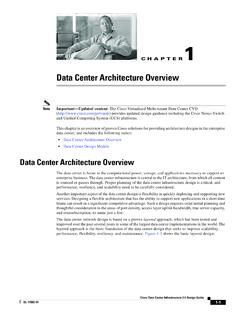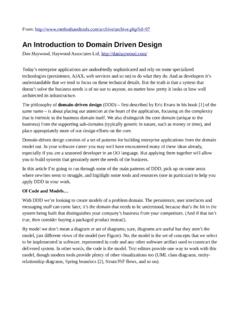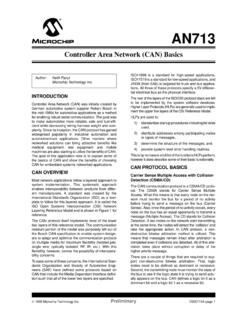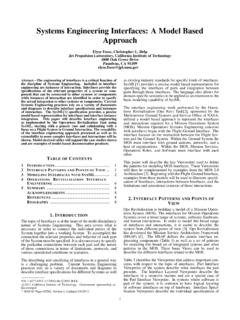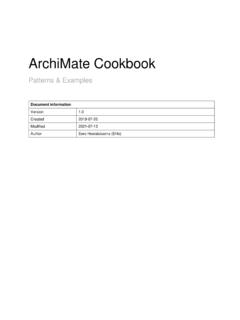Transcription of Dimensional Modelling by Example - Database Answers
1 Dimensional Modelling by Example Page 1 04/09/2014 13:02 Dimensional Modelling by Example Barry Williams Dimensional Modelling by Example Page 2 04/09/2014 13:02 1. Management Summary .. 5 The Purpose of this Book .. 5 The Contents of this Book .. 5 Three Stages .. 5 What are Dimensional Models ? .. 5 Data Marts .. 6 Best Practice .. 7 Types of Dimensional Models .. 7 How to use the Dimensional Models .. 12 2. Getting Started .. 12 Design Guidelines - a Four-Step Approach .. 12 Always use Surrogate Keys.
2 12 Agree an architecture .. 13 Conceptual Data Models .. 18 Using Dimensional Models for Reports .. 21 Dates and Flattened Hierarchies .. 22 3. Reaching Maturity .. 23 Semantic Layer .. 23 Self-Service BI .. 25 Churn - Analysing Churn Rate .. 25 Promotions Analysing Promotions Effectiveness .. 27 Conformed Dimensions .. 29 Systems and Design Patterns .. 30 Add new Requirements .. 31 4. Keeping Things Ticking Over .. 31 Governance .. 31 Dimensional Modelling by Example Page 3 04/09/2014 13:02 Data 31 User Involvement .. 31 Appendix A.
3 Library of Dimensional Models .. 32 Advertising .. 32 Afghanistan Encounters .. 34 Airline Operations .. 36 American Studies .. 38 Amusement Parks .. 40 Anti Money-Laundering .. 42 Banking Investment .. 44 Banking Retail .. 46 Boy Scouts .. 48 Clown Registry .. 50 Commercial Properties .. 52 Cruise Ships .. 54 Customers and Car Parts .. 56 Day at the Olympics .. 58 Dog the Bounty Hunter .. 60 Dog Whisperer .. 62 Financial Services .. 64 Football .. 66 e-Commerce .. 68 Entertainment .. 70 Event Processing .. 72 Golf Memorabilia.
4 74 Gym Training Diaries .. 76 Hotel Reservations .. 78 Dimensional Modelling by Example Page 4 04/09/2014 13:02 Insurance .. 80 Library Donations .. 82 Local Government .. 84 Logistics .. 86 Pharmaceutical Companies .. 88 Pool Hall Management .. 91 Property Tax Appeal .. 93 Public Transport .. 95 Puppies Tricks .. 97 Radio Stations .. 99 Recycling and Garbage Collection .. 101 Restaurant Guides .. 103 Retail .. 105 Student Registration .. 107 Telecomms Companies .. 109 Tracking Printer Cartridges .. 111 Traffic Cops and Tickets.
5 113 Travel and Transport .. 115 Usual Suspects .. 117 Utilities .. 119 Vulnerable People .. 121 Waste Management .. 123 Wedding Parties .. 125 Wine .. 127 Yakuza Japanese Organised Crime .. 129 Zoos .. 131 Dimensional Modelling by Example Page 5 04/09/2014 13:02 1. Management Summary The Purpose of this Book The purpose of this book is to offer an introduction to Dimensional Modelling . It contains some background and theory and a Library of fifty Industry-specific Models to help you get started in creating something specific to your requirements.
6 I also teach a Course and provide consulting services based on the contents of his Book. If you have questions or need help, please feel free to email me. The Contents of this Book The contents of this book include all the major topics of interest in the area of Dimensional Modelling . Three Stages These Topics are covered in three Stages which are covered later in this Book :- 1. Getting Started 2. Reaching Maturity 3. Keeping Things Ticking Over What are Dimensional Models ? The concept of Dimensional Modelling was developed by Ralph response to a demand from end-users for an easy way to specify Reports.
7 This contrasted with the alternative Corporate Information Factory , the vision of Bill Inmon. Dimension Modelling Self-Service BI Conformed Dimensions Fact Tables Factless Facts Snapshots Accumulative Snapshots Aggregate Snapshots Dimensional Modelling by Example Page 6 04/09/2014 13:02 This diagram shows a Dimensional Model that Ralph Kimball has published on his Web Site for a Retail Point of Sales :- It shows very clearly the approach which can be described very simply as The data that can be measured are called the Facts and they are stored with the things that can be measured by, which are called the the Dimensions.
8 In this simple Example . Kimball has kindly given all the Dimensions names ending Dimensions , and there are three Facts that are called Dollars Sold, Units Sold and Dollars Cost. Data Marts We use the term Data Mart as an alternative to Dimensional Model . We consider that they both mean the same but we sometimes use Data Mart in a way that might include more than one Dimensional Model, especially for a functional area, such as Sales. We refer to the majority of our Models as Dimensional Models, but occasionally we call them Data Marts which we prefer because it is more flexible.
9 Dimensional Modelling by Example Page 7 04/09/2014 13:02 Best Practice Where appropriate, we consider the Kimball Web Site as our definitive source of Best Practice in Data Modelling :- If you are looking for a good background, this page on Dimensional Modelling Techniques on the Kimball Web Site is highly recommended :- Wikipedia is usually worth a look, and here is the entry for Dimensional Modelling :- An excellent writer is Chris Adamson who has published a great book called Star Schema :- As a backup reference, we use Discussion Groups in LinkedIn like this one on DW Dimensional Modelling :- In LinkedIn, one good thing is that we can ask specific questions if we are seeking a majority view of Best Practice or Recommended Guidelines.
10 Types of Dimensional Models We can identify five distinct types of Dimensional Models which are discussed below :- Accumulating Snapshot Tables Aggregate Tables Fact Tables Factless Fact Tables Snapshot Tables Dimensional Modelling by Example Page 8 04/09/2014 13:02 Accumulating Snapshot Tables A common Example involves the use of a Stage or Status Dimension which is used to track progress through the Snapshots. In the first Example , we have added a Stage Dimension and we add records at the successive Stages of a Passenger s progress Airline Example This Example of an Accumulating Snapshot Fact Table for Airline Operations shows how we can track the progress of a Passenger.




